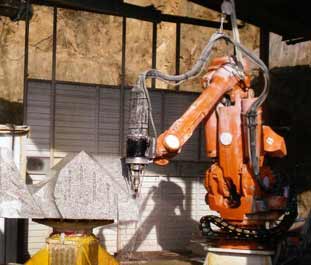Robots working stones
 Antoni Gaudí's designs were so rational, so removed of the caprice and so based on the geometry and the mechanics with which there is done the Nature, which seems as if he had felt that, spent the years, could develop with the modern current technologies.
The image of the stonecutter craftsman, with years of trade at the foot of work, has disappeared.
On one hand, because in the lot of the Sagrada Família there is no space for the carved one of the stones, which has to be done in other places, out of Barcelona, in the ships of the suppliers.
And of another part because, from 1989, it is done by machines of numerical control, with an articulated arm, which allows to work with seven axes, two in the bench and five in the arm.
With the computer programming, the machine can do accurately even the designs of more geometric complexity that the master left, based on quadric ruled surfaces and helicoids. The sections of the columns, for example, divide, in the base, of two figures starred with six, eight, ten or twelve vertexes rounded by concave and convex parables, which rise turning spirally one in sense and other one in contrary sense.
Gaudí was doing models of plaster, which were destroyed during the religious pursuit against the Catholics of 1936, on having begun the Spanish Civil War.
Many pieces have been recovered and from them the professionals, with help of the computer, re-do the pieces, which later are carved by total precision by the robotic arms. Once the controls have passed, the pieces come to the Sagrada Família, where they are proceeded to mount.
And the architects and engineers act like Gaudí: they do a model to natural size of a soft material, in this case plastic, and put it in the place where the definitive piece will go, to verify the form and the measures. "To see the aspect that they have before putting them of stone ", says the architect Jordi Faulí, repeating Gaudí's explanation.
Antoni Gaudí's designs were so rational, so removed of the caprice and so based on the geometry and the mechanics with which there is done the Nature, which seems as if he had felt that, spent the years, could develop with the modern current technologies.
The image of the stonecutter craftsman, with years of trade at the foot of work, has disappeared.
On one hand, because in the lot of the Sagrada Família there is no space for the carved one of the stones, which has to be done in other places, out of Barcelona, in the ships of the suppliers.
And of another part because, from 1989, it is done by machines of numerical control, with an articulated arm, which allows to work with seven axes, two in the bench and five in the arm.
With the computer programming, the machine can do accurately even the designs of more geometric complexity that the master left, based on quadric ruled surfaces and helicoids. The sections of the columns, for example, divide, in the base, of two figures starred with six, eight, ten or twelve vertexes rounded by concave and convex parables, which rise turning spirally one in sense and other one in contrary sense.
Gaudí was doing models of plaster, which were destroyed during the religious pursuit against the Catholics of 1936, on having begun the Spanish Civil War.
Many pieces have been recovered and from them the professionals, with help of the computer, re-do the pieces, which later are carved by total precision by the robotic arms. Once the controls have passed, the pieces come to the Sagrada Família, where they are proceeded to mount.
And the architects and engineers act like Gaudí: they do a model to natural size of a soft material, in this case plastic, and put it in the place where the definitive piece will go, to verify the form and the measures. "To see the aspect that they have before putting them of stone ", says the architect Jordi Faulí, repeating Gaudí's explanation.
All rights reserved
Last update: 06/05/2016